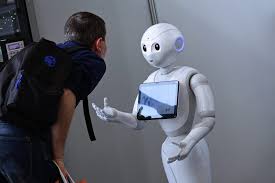Future of humanoid robots and humanoid robot companies
Welcome to a world where science fiction meets reality – the realm of humanoid robots. These remarkable machines, with their human-like appearance and advanced capabilities, have captivated our imaginations for decades. From the iconic characters in movies like “Star Wars” and “Blade Runner,” to the cutting-edge robotics being developed today, humanoid robots are no longer just a fantasy. In this blog post, we will explore the fascinating world of humanoid robots: what they are, their history, and most importantly, what lies ahead for these futuristic marvels. So strap in and get ready to delve into the exciting future of humanoid robots!
What are humanoid robots?

What exactly are humanoid robots, you may ask? Well, simply put, they are machines designed to resemble the human form. These incredible creations mimic not only our physical appearance but also attempt to replicate our movements and behaviors. With their sophisticated mechanisms and sensors, humanoid robots can walk, talk, gesture, and even interact with humans in a way that feels eerily lifelike.
There are various types of humanoid robots out there – some built for research purposes and others intended for practical applications. Research-oriented models often focus on advancing our understanding of human locomotion and cognition. They serve as valuable tools for scientists studying biomechanics or exploring artificial intelligence.
On the other hand, practical humanoid robots have more diverse roles in industries such as healthcare, entertainment, and personal assistance. Imagine having a robot companion by your side at home or a robotic nurse providing care in hospitals – these scenarios might soon become a reality thanks to the continuous advancement of technology.
The beauty of humanoid robots lies not just in their resemblance to us but also in their potential to perform tasks that humans find challenging or dangerous. By utilizing their dexterity and adaptability, they could revolutionize industries like manufacturing by taking over intricate assembly tasks or working alongside humans collaboratively.
As we continue pushing the boundaries of robotics technology further each day, it’s exciting to envision how far we can go with creating ever more advanced versions of humanoid robots. From enhanced sensory capabilities to increased autonomy through machine learning algorithms—the possibilities seem endless!
Stay tuned as we delve deeper into the history of these remarkable machines next!
The different types of humanoid robots

When it comes to humanoid robots, there are several different types that have been developed and continue to evolve. Each type serves a specific purpose and has its own unique capabilities.
One type of humanoid robot is the service robot. These robots are designed to assist humans in various tasks, such as household chores or providing customer service. They can be programmed to perform a wide range of actions, from cooking and cleaning to answering questions and offering recommendations.
Another type of humanoid robot is the research robot. These robots are typically used in scientific studies and experiments. They are equipped with advanced sensors and technology that allow them to gather data, analyze it, and provide valuable insights for researchers.
Medical robots are another category of humanoid robots that hold great potential in the healthcare industry. These robots can assist doctors during surgeries or help patients with rehabilitation exercises. With their precision movements and ability to interact with human patients, medical robots have the potential to revolutionize healthcare practices.
Furthermore, there are also entertainment robots that aim at providing companionship or amusement for people. From interactive toys for children to lifelike robotic pets for elderly individuals who may feel lonely or isolated, these entertainment-focused humanoid robots offer an innovative way to bring joy into our lives.
In conclusion,
the world of humanoid robotics holds immense promise for the future. As technology continues to advance at a rapid pace, we can expect even more sophisticated and capable humanoid robots entering our lives soon.
The history of humanoid robots
The history of humanoid robots is a fascinating journey that dates back to ancient times. While the concept of creating machines in human-like form has long captured the imaginations of inventors, it wasn’t until the 20th century that significant advancements were made.
In the early 1920s, Czech writer Karel Čapek introduced the term “robot” in his play “R.U.R.” (Rossum’s Universal Robots), which depicted artificial beings designed for labor. This marked a turning point in popular culture and laid the foundation for future developments.
Fast forward to the mid-20th century, when researchers began experimenting with robotics and automation. In 1956, George Devol and Joseph Engelberger created Unimate, an industrial robot arm that revolutionized manufacturing processes. Though not humanoid in appearance, this invention paved the way for further exploration into robotic technology.
It wasn’t until later decades that true humanoid robots emerged on the scene. One striking model is Honda’s ASIMO, presented in 2000. ASIMO showcased remarkable capabilities such as walking on two legs and recognizing voices and faces. This breakthrough sparked renewed interest in developing robots with human-like qualities.
Today, scientists continue to push boundaries by designing increasingly sophisticated humanoid robots capable of performing complex tasks like assisting humans in various industries or even providing companionship to those who need it most.
As technology continues to evolve at rapid speeds, we can only imagine what lies ahead for humanoid robots – from more realistic appearances to enhanced cognitive abilities. The potential applications are vast: from aiding healthcare professionals to exploring hazardous environments where humans cannot safely venture alone.
The history of humanoid robots serves as a testament to our collective desire to create machines that mirror ourselves – embodying our strengths while offering new possibilities beyond our own limitations. As we march towards an exciting future filled with incredible innovations, one thing remains certain: humanity’s quest for anthropomorphic machines will persist as long as there are dreamers and visionaries to bring them to life.
Share this post:

